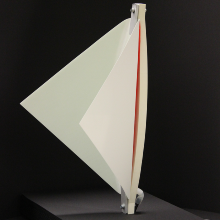Within project A04 of the Collaborative Research Center Transregio 141, biological principles with regard to their motion kinematics were examined in relation to their transferability into bio-inspired adaptive building skins.
Based on a biological screening process, the movement of the underwater snap-trap Aldrovanda vesiculosa was considered to be particularly promising for a technical implementation and subjected to a closer investigation.
The motion principle of this aquatic plant was explored experimentally and simulatively. The kinematic was abstracted towards the curved-line folding principle. Simulations of different folding geometries regarding material stresses, required actuation energies as well as the resistance to external loads led to the generation of an optimal geometry for façade shading. At the same time, a multi-material structure made of glass fiber-reinforced plastic and elastomer has been developed, which makes folding of composite components possible. Material and movement principle were implemented in an adaptive façade shading system, the Flectofold (AVK Award 2017).
The material developed in A04 was shown and tested in a large-scale demonstrator (36 Flectofold elements) in the Rosenstein Museum in Stuttgart within the special exhibition "Baubionik – Biologie beflügelt Architektur" (October 2017 – May 2018).
Flectofold large-scale Demonstrator – BauBionik Exhibition
The video shows the development of the façade shading system Flectofold from the biological analysis via abstraction and simulation as well as the technical material investigation and realization of the findings in a large-scale demonstrator. It was shown and tested within the special exhibition "Baubionik – Biologie beflügelt Architektur" at Schloss Rosenstein/Natural History Museum Stuttgart.
Project Duration
Oktober 2014 – June 2018
Project Team
ITFT Institute for Textile and Fiber Technologies,
University of Stuttgart
Prof. Dr.-Ing. Götz T. Gresser, Larissa Born
ITKE Institute for Building Structures and Structural Design,
University of Stuttgart
Prof. Dr.-Ing. Jan Knippers, Axel Körner, Saman Saffarian
IBB Institute for Structural Mechanics,
University of Stuttgart
Prof. Dr.-Ing. Manfred Bischoff, Renate Sachse
PBG Plant Biomechanics Group,
University of Freiburg
Prof. Dr. Thomas Speck, Simon Poppinga, Anna S. Westermeier
Publications within the scope of this project
Born L, Körner A, Mader A, Schieber G, Milwich M, Knippers J et al. Adaptive FRP Structures for Exterior Applications. Adv. Mater. Lett. 2019;10(12):913–8. https://doi.org/10.5185/amlett.2019.0029.
Born L, Körner A, Schieber G, Westermeier AS, Poppinga S, Sachse R et al. Fiber-Reinforced Plastics with Locally Adapted Stiffness for Bio-Inspired Hingeless, Deployable Architectural Systems. KEM 2017;742:689–96. https://doi.org/10.4028/www.scientific.net/KEM.742.689.
Körner A, Born L, Mader A, Sachse R, Saffarian S, Westermeier AS et al. Flectofold—a biomimetic compliant shading device for complex free form facades. Smart Mater. Struct. 2018;27(1):17001. https://doi.org/10.1088/1361-665X/aa9c2f.
Poppinga S, Körner A, Sachse R, Born L, Westermeier A, Hesse L et al. Compliant Mechanisms in Plants and Architecture. In: Knippers J, Nickel KG, Speck T, editors. Biomimetic Research for Architecture and Building Construction. Cham: Springer International Publishing; 2016, p. 169–193.
Saffarian S, Born L, Körner A, Mader A, Westermeier AS, Poppinga S et al. From Pure Research To Biomimetic Products: The Flectofold Facade Shading Device. In: Knippers J, Schmid U, Speck T, editors. Biomimetics for Architecture. De Gruyter; 2019, p. 42–51.
Westermeier A, Poppinga S, Körner A, Born L, Sachse R, Saffarian S et al. No Joint Ailments: How Plants Move And Inspire Technology. In: Knippers J, Schmid U, Speck T, editors. Biomimetics for Architecture. De Gruyter; 2019, p. 32–41.
Funding
This research has been funded by the German Research Foundation (DFG) as part of the Transregional Research Centre (SFB/Transregio) 141 ‘Biological Design and Integrative Structures’ / project A04.
Further Information on the Collaborative Research Centre (CRC) TRR-141
Contact

Larissa Born
Dr.-Ing.Deputy Director





